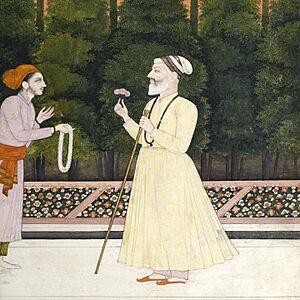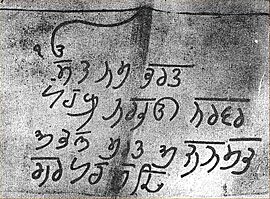Guru Har Rai facts for kids
Quick facts for kids Guru Har Rai |
|
|---|---|
| ਗੁਰੂ ਹਰਿ ਰਾਇ | |

Guru Har Rai receives a devotee. Family workshop of Nainsukh of Guler, Punjab Hills, ca.1790
|
|
| Religion | Sikhism |
| Other names | Seventh Master Seventh Nanak' |
| Personal | |
| Born | 16 January 1630 Kiratpur Sahib, Lahore Subah, Mughal Empire (present-day Rupnagar district, Punjab, India) |
| Died | 6 October 1661 (aged 31) Kiratpur Sahib, Lahore Subah, Mughal Empire (present-day Rupnagar district, Punjab, India) |
| Spouse | Mata Krishen Devi (also known as Sulakhni, Kot Kalyani, or Kishan Kaur) |
| Children | Baba Ram Rai Guru Har Krishan |
| Parents | Baba Gurditta (father) ,
Mata Nihal Kaur (mother) Baba Daya Ram (father in law) Mata Ananti (mother in law) |
| Religious career | |
| Period in office | 1644–1661 |
| Predecessor | Guru Hargobind |
| Successor | Guru Har Krishan |
| Signature |  |
Guru Har Rai was the seventh of the ten Sikh Gurus. He was born on January 16, 1630, and passed away on October 6, 1661. He became the Sikh leader at age 14, on March 3, 1644. This happened after his grandfather, Guru Hargobind, the sixth Sikh Guru, passed away. Guru Har Rai guided the Sikhs for about 17 years until his death at age 31.
Guru Har Rai is known for keeping the large army of Sikh soldiers that the sixth Guru had built. However, he always tried to avoid fighting. He supported Dara Shikoh, who was a moderate prince, instead of his brother Aurangzeb. The two brothers were fighting to become the next ruler of the Mughal Empire.
After Aurangzeb won the battle for the throne in 1658, he called Guru Har Rai to explain why he had supported Dara Shikoh. This happened in 1660. Guru Har Rai sent his older son, Ram Rai, to represent him. Aurangzeb kept Ram Rai as a hostage. He questioned Ram Rai about a verse in the Adi Granth, which was the holy book of Sikhs at that time. Aurangzeb thought the verse was disrespectful. Ram Rai changed the verse to make Aurangzeb happy. Because of this, Guru Har Rai removed his older son from the line of succession. He chose his younger son, Har Krishan, to be the next Guru. Har Krishan became the eighth Guru at age five after Guru Har Rai's death in 1661.
Contents
Life of Guru Har Rai
Guru Har Rai was born in a Sodhi Khatri family. His parents were Baba Gurditta and Mata Nihal Kaur (also known as Ananti). His father passed away when Guru Har Rai was only 8 years old. In 1640, at age 10, Guru Har Rai married Mata Kishan Kaur. She is sometimes also called Sulakhni. They had two sons, Ram Rai and Har Krishan. Har Krishan later became the eighth Sikh Guru.
Guru Har Rai had an older brother named Dhir Mal. Dhir Mal had received support from the Mughal emperor Shah Jahan. He got free land and help from the Mughal government. Dhir Mal tried to create his own Sikh group and criticized his grandfather, Guru Hargobind. Guru Hargobind did not agree with Dhir Mal's actions. So, he chose the younger Har Rai to be his successor.
Helping Prince Dara Shikoh
Guru Har Rai provided medical care to Prince Dara Shikoh. It is possible that Dara Shikoh had been poisoned by Mughal agents. Records from the Mughal Empire show that Guru Har Rai also helped Dara Shikoh in other ways. This was when Dara Shikoh and his brother Aurangzeb were fighting for control of the empire.
Aurangzeb eventually won the fight. He arrested Dara Shikoh and had him executed. In 1660, Aurangzeb asked Guru Har Rai to come and explain why he had helped Dara Shikoh.
In Sikh tradition, people asked Guru Har Rai why he was helping Dara Shikoh. They pointed out that Dara Shikoh's ancestors had treated Sikhs and Sikh Gurus badly. Guru Har Rai is believed to have replied that if a person picks flowers with one hand and gives them away with the other, both hands will smell the same sweet fragrance. This meant that helping someone in need is always good.
After Aurangzeb became the emperor, he again called Guru Har Rai in 1660. Guru Har Rai sent his 13-year-old son, Ram Rai, to meet Aurangzeb. Aurangzeb kept Ram Rai as a hostage. He asked Ram Rai about a verse in the Adi Granth. Aurangzeb thought this verse was insulting to Muslims. Ram Rai changed the meaning of the verse to please Aurangzeb. He did not stand by the original Sikh scripture. Because of this, Guru Har Rai removed Ram Rai from the line of succession. He then chose his younger son, Har Krishan, to be the next Guru of Sikhism.
Sikh Traditions and Reforms
Guru Har Rai started several new traditions for public singing and reading of Sikh scriptures. He added katha, which are spoken religious talks, to the sabad kirtan (singing of hymns) tradition. He also started the akhand kirtan, which is a continuous singing of scriptures. Another tradition he added was jotian da kirtan, which is a group folk singing of scriptures.
Keeping Sikhs United
The third Sikh Guru, Guru Amar Das, had set up a system to organize the Sikh community. He created Manjis, which were religious zones with leaders called sangatias. He also started the dasvandh system, where Sikhs would donate one-tenth of their income to the Guru. This money was used for community religious resources. Guru Amar Das also began the famous langar tradition. In langar, anyone, no matter who they are, can get a free meal in a communal setting.
This strong organization helped Sikhs grow and resist the Mughal rulers. However, it also created some new challenges for Guru Har Rai. Some of the donation collectors, called Masands, along with Dhir Mal (Guru Har Rai's older brother), tried to cause divisions among Sikhs. They were encouraged by Shah Jahan and the Mughal government. They tried to create their own separate Sikh groups and leaders. This was an attempt to weaken the Sikh religion. So, one of Guru Har Rai's main tasks was to keep the Sikhs united.
To do this, he appointed new and trustworthy masands. These included Bhai Jodh, Bhai Gonda, Bhai Nattha, Bhagat Bhagwan (for eastern India), Bhai Pheru (for Rajasthan), and Bhai Bhagat (also known as Bairagi). These new leaders helped manage the Manjis.
Succession
Before his death, Guru Har Rai appointed his 5-year-old youngest son, Har Krishan, as the eighth Guru of the Sikhs.
Images for kids





